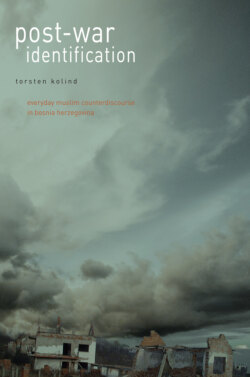Читать книгу Post-War Identification - Torsten Kolind - Страница 21
Narratives
ОглавлениеIt is difficult to uphold a division between, on the one hand, the experience of loss of meaning and, on the other, the narratives people use to explain and make sense of this loss, especially if both matters are only revealed to the ethnographer in communication. That is to say, what part of communication expresses the pure and unmediated experience of violence and what part is a narrative representation of it? In medical anthropology, the idea of pure existential experience has flourished (Kleinman and Kleinman 1995, Good 1994); the same can be considered true in experientially oriented war anthropology. The critical philosophical problem, however, is that experience must always pass through language to be visible/audible (Mead 1967). Some studies have nevertheless focused more on the narratives used to make sense of the violence experienced and the destroyed everyday world than on the ‘pure experience’ that the unmaking of the world can be said to represent − which may be due to the ethnographer’s arrival after the violence has stopped (Zur 1998; Warren 1993; Malkki 1998; Mehta 2001; Jansen 2000a, 2000b; Das 1990, 2001; Perera 2001; Kolind 2006, 2007; Jackson 2002). In these studies, the concept of narrative6 (or similar concepts) is often used to systematise informants’ more or less ordered and identifiable versions of events and relate them to the overarching discourses in which they are cast. In a study of Hutu refugees’ memory of violence, Malkki (1998), for instance, found what she calls a ‘mythico-history’, or cosmological ordering of the past, a ‘world-making.’ The Hutus construct themselves in their attempt to seize history, condemn the Tutsis’ atrocities, and legitimise their own position in Rwandan society. Malkki (1998) does not try to sort out true facts from invented ones in these mythico-histories:
Different regimes of truth exist for different historical actors, and particularly historical events support any number of different narrative elaborations. (p. 104).
What her analysis misses, though, is a consideration of other possible ‘regimes of truth’ or discourses that affect the Hutus’ narratives. In a more phenomenologically inspired narrative approach, Jackson (2002) focuses on what he calls ‘the politics of storytelling.’ In the face of violent events and other disempowering circumstances, storytelling (narratives) – understood as “a result of ongoing dialogue and redaction within fields of intersubjectivity” (ibid. 22) – can be seen as a way to transform private meanings into public ones and to sustain a sense of agency, both vital aspects for human existence. In other words, the very act of putting experience into words (and thereby sharing it, making it part of the social) is theorised as a necessary human capacity to overcome the ‘unmaking of the world’ and recreate a meaningful life.
However, it is also possible to think about narratives and people’s categorisations as less consistent and static than the prevalent use of narratives seems to indicate. When primarily focusing on the ability of narratives to order the world cosmologically and morally, one may overlook the more chaotic, fragmented and contradictory aspect of social life and its strategic uses, especially in post-war societies. The branch of anthropology inspired by Mary Douglas, which basically sees human activity as cosmological ordering of the world, may overlook another feature of social interaction: the persistent situational and strategic mixing of categories. In a study of post-war Croatia, Jansen (2000b, 2006), for instance, shows how on the surface people reproduce the nationalistic rhetoric that has poisoned the whole area, but on closer inspection what looks like conformism is rather a manifestation of agents’ situational and concrete strategies. For instance, a Croat family (from Bosnia) living in a Serbian house in Croatia evoked the authoritative nationalist discourse of ‘language right’ (even though the languages are nearly identical and even though before the war the family lived peacefully with their Bosnian Serb and Muslim neighbours), which allowed them “to resist subjection to another, possible threatening discourse, that of rights of property and return” (Jansen 2000b: 14). This example shows the intricate relationship between discourse and agency, or the way in which people’s narratives of the war are both situational and strategic.
For some scholars the recent shift in the anthropology of war and violence focusing on experience and narratives is perceived as a blind alley. Schmidt and Schröder (2001) argue, for instance, that this “postmodernist shift in anthropological research on violence” (ibid.7), as they call it, is a hindrance to comparative anthropology. Violence, they claim, can easily be compared to its causes, events and results, but not to its subjective experience of these things. I do not agree. I think that one can actually distinguish some core themes in this ‘postmodernist’ ethnography of war and violence: violence that ‘works’ via its erosion of the everyday, taken-for-granted world; ways of rebuilding meaning when people’s worlds are shattered (a comparison that could be expanded to other areas of research; see, for instance, Cohen and Taylor 1972); and a theoretical discussion of resistance and the ways in which discourses interrelate with processes of recreating meaning through narratives.
